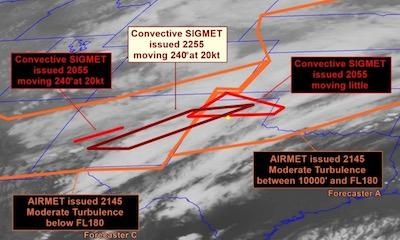Part Of An Ongoing Investigation Into A Fatal Accident Involving A Pilatus PC 12
The NTSB has issued two safety recommendations to the National Weather Service concerning forecasting low-level turbulence following an accident involving a Pilatus PC-12 which fatally injured three people.

The airplane impacted terrain near Rick Husband Amarillo International Airport (KAMA), Amarillo, TX shortly after takeoff. The airline transport pilot and two flight crewmembers were fatally injured, and the airplane was destroyed. The flight, which was operating on an instrument flight rules flight plan, was originating at the time of the accident and was en route to Clovis Municipal Airport, Clovis, New Mexico. The flight was cleared for takeoff about 2344, and the pilot reported to the AMA air traffic control (ATC) tower at 6,000 ft above mean sea level (msl) about 2347.2 About 2348, the transponder signal was lost; shortly after, a fireball was observed south of the airport.
Although this investigation is ongoing, based on weather model, weather radar, and other data, the NTSB was concerned that low-level turbulence may have been present over Amarillo below 8,000 ft on the night of the accident.
Further, the NTSB noted that while the NWS Aviation Weather Center (AWC) issued several weather advisories around the time of the accident for areas near the accident location, there were no airmen’s meteorological information (AIRMET) advisories active for turbulence below 10,000 ft at the accident location at the accident time.5 In June 2017, the NTSB visited the NWS AWC in Kansas City, Missouri, to further examine the circumstances of the accident and document the AWC’s operations regarding low-level turbulence identification and advisory issuance for turbulence.
During this visit and subsequent conversations with forecasters, the NTSB determined that (1) AWC forecasters may have varying professional criteria for issuing advisories for turbulence (like AIRMETs) when convective significant meteorological information (SIGMET) advisories are active in the same region and (2) low-level turbulence is not adequately covered in formal training for AWC or other NWS aviation forecasters.6 Although the cause of this accident is still under investigation and the role of low-level turbulence has not been specifically identified as a factor or cause, the safety risks associated with significant turbulence encounters are well known and can include serious injuries to passengers and crew. Therefore, it is important that issuance of turbulence-related weather products directed to pilots be consistent and that these products address the turbulence potential at all operating altitudes.
The NTSB obtained statements from two AWC forecasters responsible for the accident region and an AWC forecaster responsible for an adjacent region and noted that the forecasters expressed different criteria for the issuance of AIRMETs in the presence of active convective SIGMETs.
Although this accident investigation is ongoing, the NTSB is concerned, as noted above, with the lack of clear guidance for forecasters on the issuance of products that advise of nonconvective turbulence hazards (such as low-level turbulence) when convective SIGMETs are issued in the same region and looked into training available for forecasters on low-level turbulence. Postaccident conversations with an AWC forecaster and NWS personnel and our examination of training for NWS aviation meteorologists indicate that formal training for the identification of low-level turbulence is lacking. Conversations with the AWC forecaster revealed that low-level turbulence is difficult for AWC forecasters to forecast and that a training module on low-level turbulence would be beneficial. An NWS aviation program lead confirmed that there is currently no formal low-level turbulence training available to NWS forecasters.
The NTSB has recommended that the National Weather Service:
- Revise National Weather Service Instruction 10-811 to include guidance on the issuance of airmen’s meteorological information advisories and other products that advise of nonconvective turbulence hazards when convective significant meteorological information advisories are active, or may be issued, in the same region.
- Develop and provide formal training to your aviation weather forecasters on the analysis, interpretation, and forecasting of low-level turbulence.
(Image from NTSB report)
 Bolen Gives Congress a Rare Thumbs-Up
Bolen Gives Congress a Rare Thumbs-Up The SportPlane Resource Guide RETURNS!!!!
The SportPlane Resource Guide RETURNS!!!! Buying Sprees Continue: Textron eAviation Takes On Amazilia Aerospace
Buying Sprees Continue: Textron eAviation Takes On Amazilia Aerospace Hawker 4000 Bizjets Gain Nav System, Data Link STC
Hawker 4000 Bizjets Gain Nav System, Data Link STC Echodyne Gets BVLOS Waiver for AiRanger Aircraft
Echodyne Gets BVLOS Waiver for AiRanger Aircraft



